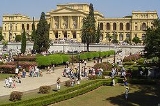
Ipiranga
Encyclopedia
Ipiranga is an historical district located in the subprefecture of the same name
of São Paulo
, Brazil
. The name Ipiranga comes from the river (which now is a brook) of the same name located in the region, which means "red river" in a Tupí–Guaraní language. The Independence Park (Parque da Independência), where supposedly the Emperor Pedro I of Brazil proclaimed the independence of Brazil, the Paulista Museum
, which exhibits classic architecture and a collection of Brazilian colonial artifacts, and the Zoology Museum, are also located in Ipiranga.
The Ipiranga Brook
is perhaps one of the most famous Brazilian brooks, because it is mentioned in the very first line of the Brazilian National Anthem
.
The region near the Tamanduateí River
had industrial characteristics, to the point where buses and trams heading there had the destination labeled "Factory". The area next to Nazaré Avenue, in contrast, is filled with mansions of wealthy families and an amount of colleges, like Unesp and São Camilo, and workers of the factorys houses.
The commercial center of Ipiranga concentrates on Silva Bueno Street. There are banks, clothes stores and grocery stores like the famous Chocolândia.
Subprefecture of Ipiranga
The Subprefecture of Ipiranga is one of 31 subprefectures of the city of São Paulo, Brazil. It comprises three districts: Ipiranga, Cursino, and Sacomã....
of São Paulo
São Paulo
São Paulo is the largest city in Brazil, the largest city in the southern hemisphere and South America, and the world's seventh largest city by population. The metropolis is anchor to the São Paulo metropolitan area, ranked as the second-most populous metropolitan area in the Americas and among...
, Brazil
Brazil
Brazil , officially the Federative Republic of Brazil , is the largest country in South America. It is the world's fifth largest country, both by geographical area and by population with over 192 million people...
. The name Ipiranga comes from the river (which now is a brook) of the same name located in the region, which means "red river" in a Tupí–Guaraní language. The Independence Park (Parque da Independência), where supposedly the Emperor Pedro I of Brazil proclaimed the independence of Brazil, the Paulista Museum
Museu Paulista
The Museu Paulista of the University of São Paulo is a Brazilian history museum located near where Emperor D. Pedro I proclaimed the Brazilian independence on the banks of Ipiranga brook in the Southeast region of the city of São Paulo, then the "Caminho do Mar," or road to the seashore...
, which exhibits classic architecture and a collection of Brazilian colonial artifacts, and the Zoology Museum, are also located in Ipiranga.
The Ipiranga Brook
Ipiranga Brook
The Ipiranga Brook is a river of São Paulo state in southeastern Brazil, historically known for has been the place where Dom Pedro I declared the independence of Brazil from the United Kingdom of Portugal, Brazil and the Algarves. Its name came from the Tupi words: "Y", which means water or river,...
is perhaps one of the most famous Brazilian brooks, because it is mentioned in the very first line of the Brazilian National Anthem
Brazilian national anthem
The Brazilian national anthem was composed by Francisco Manuel da Silva in 1831 and had been given at least two sets of unofficial lyrics before a 1922 decree by President Epitácio Pessoa gave the anthem its definitive, official lyrics, by Osório Duque-Estrada, after several changes were made to...
.
The region near the Tamanduateí River
Tamanduateí River
The Tamanduateí River is a river of São Paulo state in southeastern Brazil.-References:*...
had industrial characteristics, to the point where buses and trams heading there had the destination labeled "Factory". The area next to Nazaré Avenue, in contrast, is filled with mansions of wealthy families and an amount of colleges, like Unesp and São Camilo, and workers of the factorys houses.
The commercial center of Ipiranga concentrates on Silva Bueno Street. There are banks, clothes stores and grocery stores like the famous Chocolândia.

